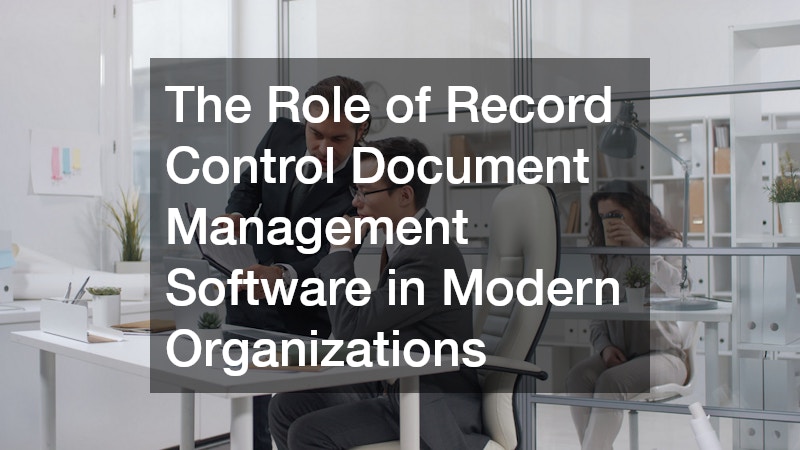In today’s rapidly evolving digital landscape, businesses of all sizes are constantly seeking innovative ways to streamline operations and maintain compliance with industry standards. One crucial aspect of business management that has gained significant attention is the organization and control of documents. This is where ” record control document management software” comes into play, offering solutions to efficiently handle and govern an organization’s document needs. This article will delve into the features and benefits of such software, providing a comprehensive understanding of its value in modern business environments.
Features of Record Control Document Management Software
The primary feature of record control document management software is its ability to organize and store documents in a centralized location. This centralization ensures that all documents are universally accessible across various departments within an organization, eliminating the chaos of misplaced files. Additionally, with comprehensive search functionalities, users can locate files swiftly, significantly reducing the time spent on document retrieval. The software is often equipped with version control, allowing users to manage and track document changes, which is particularly useful in maintaining compliance with regulatory requirements. Another feature that stands out is the user permission settings, which provide a hierarchical structure to ensure data security and restrict unauthorized access.
Automation is at the heart of effective record control document management software. The software automates routine tasks such as document workflows, approvals, and data entry. This automation not only increases efficiency but also minimizes the risk of human errors that can occur during manual processing. By automating document-related tasks, organizations can reallocate resources to focus on strategic initiatives, thus enhancing productivity and operational effectiveness. Furthermore, audit trails are a vital component, allowing businesses to maintain a clear record of who accessed specific documents and what modifications were made, thereby supporting compliance and accountability efforts.
Interoperability is another essential feature offered by top-tier record control document management software. The solution can seamlessly integrate with existing tools and systems, such as enterprise resource planning (ERP) or customer relationship management (CRM) software. Such integration creates a cohesive ecosystem where data flows freely, breaking down silos and promoting collaboration between teams. Additionally, the software often supports mobile access, enabling employees to handle documents on-the-go, which is crucial in today’s dynamic work environment. This flexibility ensures continuity and productivity regardless of geographical location or time constraints.
Benefits of Using Record Control Document Management Software
One of the most significant benefits of record control document management software is improved efficiency. By automating tasks and reducing reliance on physical paperwork, organizations can significantly reduce turnaround times on document-related projects. This efficiency often leads to a direct increase in profitability, as resources are optimized and wasted time is minimized. Furthermore, with comprehensive reporting and analytics features, decision-makers have access to valuable insights, enabling them to make informed choices that propel business growth. Overall, the improvement in efficiency afforded by such software can transform how an organization operates, paving the way for more streamlined processes and enhanced output.
Data security is another critical advantage of utilizing record control document management software. In an era where data breaches and cyberattacks are increasingly prevalent, having robust security measures in place is paramount. The software provides encryption, secure backups, and user authentication features that protect sensitive information from unauthorized access. By ensuring the confidentiality and integrity of documents, businesses not only safeguard their operations but also build trust with clients and partners. This trust is essential in maintaining long-lasting relationships and upholding a brand’s reputation in the marketplace.
Additionally, compliance with industry regulations is greatly simplified through the use of record control document management software. Many businesses operate under stringent guidelines that necessitate meticulous record-keeping and reporting. The software’s built-in compliance checking and audit trails ensure that organizations can easily demonstrate adherence to regulations during audits or inspections. This aspect alleviates the stress of regulatory compliance and reduces the potential for costly fines or legal challenges. Maintaining compliance not only supports a business’s legal obligations but also reflects its commitment to ethical standards and practices.
The Role of Record Control Document Management Software in Modern Organizations
Modern organizations are increasingly recognizing the need for scalable solutions that grow alongside their operations. Record control document management software offers unparalleled scalability, allowing businesses to expand their document handling capabilities as they evolve. This adaptability is crucial in navigating the challenges of a growing enterprise and ensures that document management systems remain effective and efficient irrespective of size or scope. As organizations internationalize and diversify, having a scalable solution becomes even more critical to maintaining coherence and accessibility across different geographical locations and departments.




